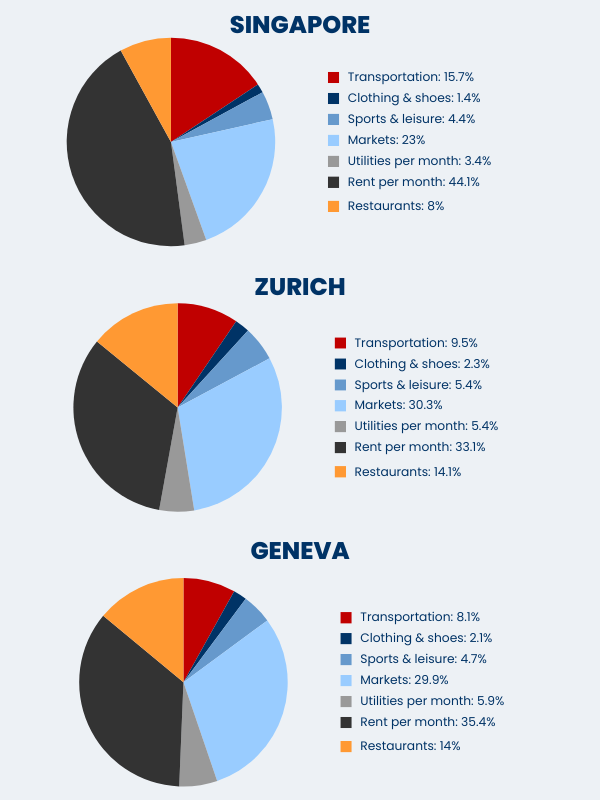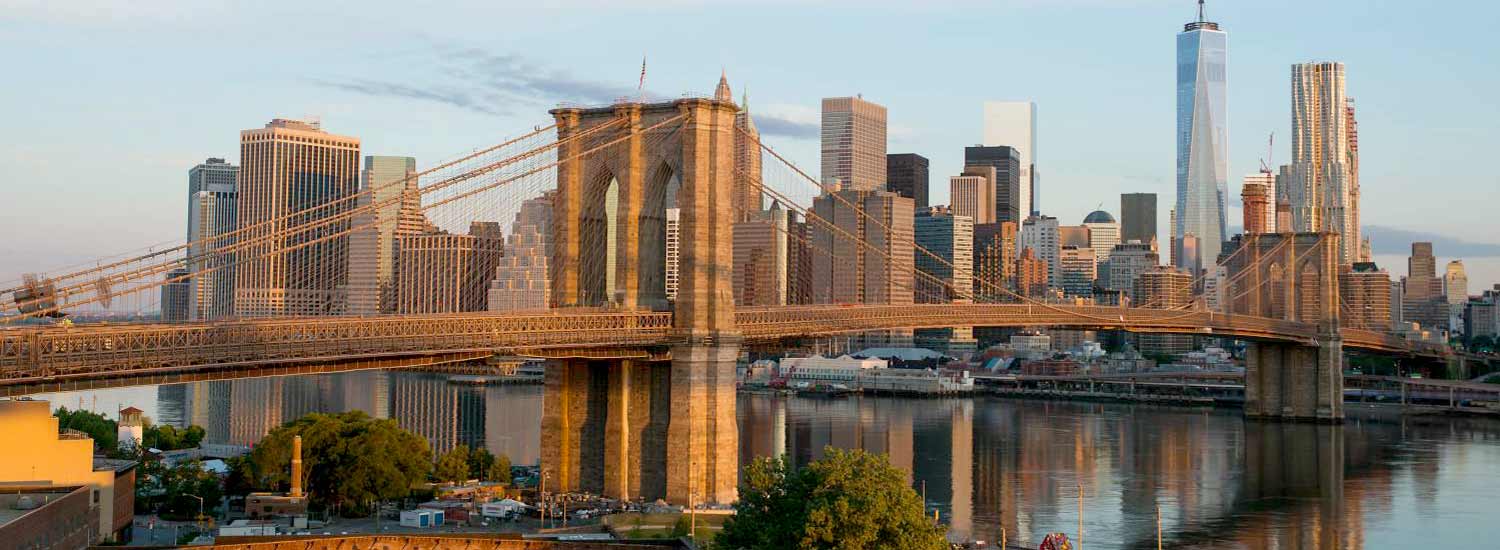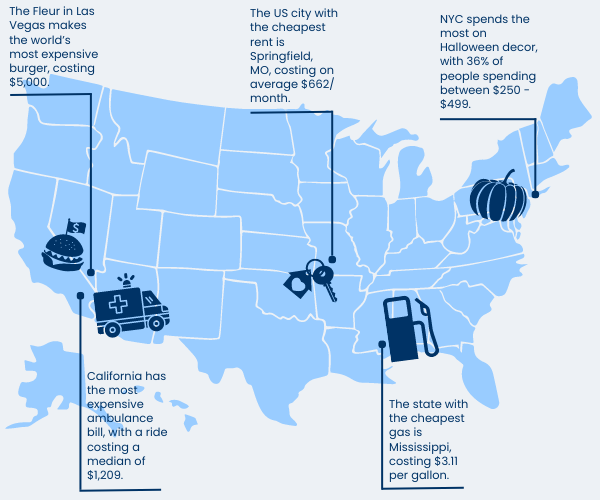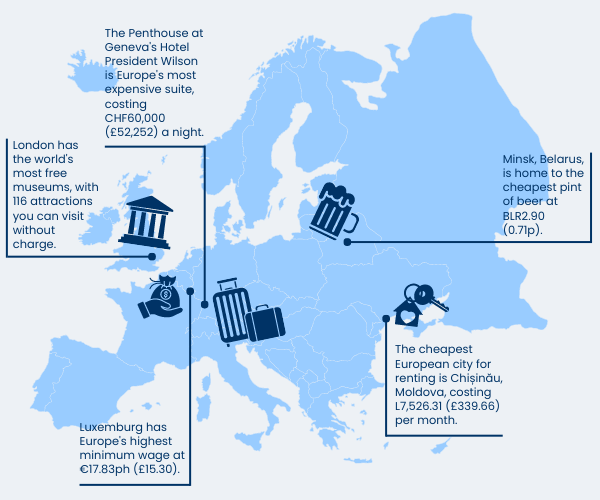Before packing, check this list of items prohibited from entering a particular country or region.
Key takeaways
- The most expensive city in the world is Zurich, according to Numbeo’s 2025 cost of living index.
- The most expensive cities in the US are New York City (New York), Los Angeles (California), San Francisco (California), Honolulu (Hawaii) and Washington, D.C. (District of Columbia).
- The most expensive cities in Europe are Zurich (Switzerland), Geneva (Switzerland), Paris (France), Copenhagen (Denmark) and Oslo (Norway).
What is the most expensive city in the world?
The most expensive city in the world is Zurich, according to Numbeo’s 2025 cost of living index, followed by Geneva, Basel, Lausanne, Lugano, Bern, New York, Reykjavik, Honolulu, and San Francisco.
Numbeo is a crowd-sourced database that tracks living costs across thousands of worldwide cities. Established in 2009, it builds price estimates via user submissions and figures from official sources, removing outliers and prioritising verified data. Each index compares everyday goods and services—such as groceries, dining out, utilities, transport and rent—with New York City set at 100. Results reflect exchange rates and local prices and offer unique insights for local budgeting, expats planning a move, and policy discussions.

6 highest cost of living cities
Switzerland dominate the results, taking all top six positions
1. Zurich (Switzerland)
Nestled amidst breathtaking Swiss scenery, it's no surprise that Zurich's picturesque surroundings, impeccable cleanliness, and high living standards come with a hefty price tag.
Another global financial powerhouse and a leading centre for banking, the city's robust economy, fueled by a strong currency and stable political environment, attracts a steady stream of affluent individuals, driving demand for premium properties and luxury goods.
2. Geneva (Switzerland)
Geneva, Switzerland's second-most populous city, is a cosmopolitan hub on the shores of Lake Geneva. Known for its diplomatic significance as the European headquarters of the United Nations, the city is a bastion of high-class living and a magnet for those with a high net worth.
Plus, Switzerland's reputation as a tax haven has long been a lure for the wealthy seeking financial security and favourable fiscal policies. However, this influx exacerbates competition for housing and services.
3. Basel (Switzerland)
Located on the Rhine at the meeting point of Switzerland, Germany, and France, Basel benefits from its role as a centre for the pharmaceutical and chemical industries.
The presence of leading global companies has made the city highly attractive to skilled professionals, increase demand for quality housing. Basel's cultural institutions, international schools, and well-connected transport links contribute to its reputation as an expensive place to live.
4. Lausanne (Switzerland)
Overlooking Lake Geneva, Lausanne combines scenic surroundings with a strong economic base. Known as the headquarters of the International Olympic Committee and many multinational companies, it draws an ambitious, multicultural community of workers.
This demand, alongside limited housing availability, keeps property and rental costs consistently high. Its universities and research centres also add to the city’s international appeal.

Most expensive cities to live in
The most expensive cities to live in are Zurich, Geneva, Basel, Lausanne, Lugano, Bern, New York, Reykjavik, Honolulu, and San Francisco, according to according to Numbeo’s 2025 cost of living index.
Switzerland dominate the results, taking all top six positions. This is largely thanks to exceptionally high wages, a strong and stable Swiss franc, and elevated prices across housing, groceries, dining. The United States has three top ten entries, and Iceland has one.
Distribution of expenses in the top 3 costliest cities:

Source: www.numbeo.com

5. Lugano (Switzerland)
Lugano stands out for its lakeside setting and proximity to Italy, with many Italian-speaking natives. It's developed into an important banking and financial services centre, attracting domestic and international wealth.
The city’s blend of Swiss efficiency and Mediterranean influence draws many visitors and expatriates. The lifestyle appeal, coupled with demand from second-home buyers, has increased accommodation costs and everyday living.
6. Bern (Switzerland)
Switzerland’s capital combines government institutions with a strong service sector. While smaller than Zurich or Geneva, its political role, UNESCO-listed old town, and high quality of infrastructure contribute to steady housing demand.
Limited space within the city centre has added to rising living costs, making Bern one of the country’s more expensive urban areas. The city’s role as a political hub and a cultural centre ensures continued interest from residents and professionals alike.
What is the most expensive state to live in?
The most expensive state to live in is Hawaii, where cost of living is
86% higher than US avg. in 2025
Source: Payscale

Most expensive cities in the US 2025*
The most expensive cities in the US are New York City (New York), Los Angeles (California), San Francisco (California), Honolulu (Hawaii) and Washington, D.C. (District of Columbia).

New York City, New York
From Broadway shows and world-class museums to iconic landmarks like Central Park and the Statue of Liberty, New York City offers endless opportunities for entertainment and recreation.
However, space is at a premium, and taxes are steep, making it a challenge for residents to find affordable housing while covering the costs of everyday essentials.
Cost of living: 132% higher than the US average
Median house price: $2,609,336 (€2,231,746)
Median rent: $7,839 (€6,704) per month
Avg. energy bill: $240 (€205) per month
Avg. petrol cost: $3.81 (€3.26) per gallon
Avg. annual salary: $94,000 (€80,397)
Most expensive neighbourhoods: Hudson Yards, SoHo, TriBeCa, Carroll Gardens and Flatiron District

Facts about the cost of living in the US

![]()
Los Angeles, California
The City of Angels boasts a vibrant lifestyle but at a hefty cost. Exorbitant fuel and property prices are the principal factors for LA's reputation as the US's second most expensive city.
However, despite the challenges, many budding actors, musicians, and entrepreneurs are drawn to Los Angeles's sunny weather, diverse culture, and booming entertainment and tech industries.
Cost of living: 50% higher than the US average
Median house price: $1,208,660 (€1,033,758)
Median rent: $3,631 (€3,105) per month
Avg. energy bill: $222 (€190) per month
Avg. petrol cost: $4.44 (€3.80) per gallon
Avg. annual salary: $92,000 (€78,686)
Most expensive neighbourhoods: Bel Air, Beverly Crest, Venice, Hollywood Hills West and Cheviot Hills

San Francisco, California
San Francisco's status as a tech mecca comes with a formidable cost of living. Even modest condos sell for huge prices, squeezing budgets and prompting creative housing solutions like co-living arrangements and micro-apartments.
Yet, amidst these challenges, Frisco's progressive ethos and innovative spirit continues to captivate, making it a city of both opportunity and resilience.
Cost of living: 65% higher than the US average
Median house price: $1,354,488 (€1,354,488)
Median rent: $4,069 (€3,480) per month
Avg. energy bill: $328 (€281) per month
Avg. petrol cost: $4.64 (€3.97) per gallon
Avg. annual salary: $117,000 (€100,069)
Most expensive neighbourhoods: Presidio Heights, Sea Cliff, Presidio Terrace, Cow Hollow and Marina District
![]()
Honolulu, Hawaii
Honolulu's breathtaking beauty, warm climate, and Aloha spirit make it a coveted destination. However, due to Hawaii's isolated location, the island relies heavily on imports, making groceries and everyday essentials pricey.
And with everyone looking for their own little slice of paradise, the property market is expensive, with median home prices well above the national average.
Cost of living: 86% higher than the US average
Median house price: $1,590,097 (€1,359,998)
Median rent: $4,777 (€4,085) per month
Avg. energy bill: $415 (€354) per month
Avg. petrol cost: $4.41 (€3.77) per gallon
Avg. annual salary: $81,000 (€69,278)
Most expensive neighbourhoods: Kahala, Diamond Head, Waikiki, Black Point and Portlock
![]()
Washington, D.C.
The United States capital is the country's political heart. The continuous influx of tourists and affluent residents, attracted by the city's history and exciting employment opportunities, leads to tough competition for accommodation and steep costs.
Additionally, residents of D.C. face some of the highest tax rates in the country, including income, property and sales taxes.
Cost of living: 39% higher than the US average
Median house price: $1,285,985 (€1,099,893)
Median rent: $3,863 (€3,304) per month
Avg. energy bill: $200 (€171) per month
Avg. petrol cost: $3.39 (€2.90) per gallon
Avg. annual salary: $90,000 (€76,976)
Most expensive neighbourhoods: Georgetown, Kalorama, Capitol Hill, Spring Valley and Chevy Chase
Source: Payscale
*according to costs and exchange rates on the day of writing.
What does cost of living refer to?
Cost of living refers to the amount of money required to sustain a certain standard of living in a particular location over a specified period. It encompasses various expenses such as housing, groceries, transportation, healthcare, utilities, and entertainment.
Other factors influencing the cost of living include housing prices, taxation, inflation rates, availability of goods and services, and overall economic conditions. Living cost indexes compare the affordability of different cities or regions, with the higher positions on the index indicating higher costs. Understanding the cost of living is essential for budgeting a move abroad and assessing the affordability of living in a specific area.

Most expensive cities in Europe 2025*
The most expensive cities in Europe are Zurich (Switzerland), Geneva (Switzerland), Paris (France), Copenhagen (Denmark), and Oslo (Norway).
![]()
Zurich, Switzerland
As Switzerland's economic powerhouse and one of Europe's most desirable cities, Zurich's cost of living is notoriously high, driven by steep housing costs.
Although a move to Switzerland requires careful budgeting and financial planning, Zurich offers residents access to top-notch healthcare and education against a stunning Alpine backdrop.
Single person est. monthly costs: 4,033 CHF ($5,019)
Avg. property price per m² (city centre): 19,389 CHF ($24,130)
Avg. monthly rent (1-bed city centre): 2,097 CHF ($2,609)
Avg. monthly utility bill: 210 CHF ($261)
Avg. petrol cost: 1.80 CHF ($2.24) per litre
Avg. annual salary: 78,204 CHF ($97,328)
Most expensive neighbourhoods: Seefeld, Fluntern, Hottingen, Enge and Escher Wyss

Facts about the cost of living in Europe

![]()
Geneva, Switzerland
Geneva, Switzerland's cosmopolitan gem, is renowned for luxury and refinement. However, finding affordable housing can be challenging because the city only covers a small geographic area.
Fortunately, from the World Health Organisation to the United Nations, Geneva is a magnet for diplomacy, finance, and international organisations, providing ample job prospects.
Single person est. monthly costs: 4,428 CHF ($5,510)
Avg. property price per m² (city centre): 17,756 CHF ($22,098)
Avg. monthly rent (1-bed city centre): 1,997 CHF ($2,485)
Avg. monthly utility bill: 217 CHF ($270)
Avg. petrol cost: 1.82 CHF ($2.27) per litre
Avg. annual salary: 72,852 CHF ($90,667)
Most expensive neighbourhoods: Cologny, Vieille Ville, Champel, Pâquis and Florissant
![]()
Paris, France
Paris offers unparalleled cultural richness, historical charm, and cosmopolitan flair, but at a premium price. The city's global status fuels high demand for housing, leading to limited availability and inflated prices for both rentals and real estate.
It also attracts millions of tourists annually, boosting the cost of attractions, dining and entertainment, and ultimately driving up expenses for residents.
Single person est. monthly costs: €3,971 ($4,645)
Avg. property price per m² (city centre): €11,880 ($13,897)
Avg. monthly rent (1-bed city centre): €1,418 ($1,658)
Avg. monthly utility bill: €223 ($260)
Avg. petrol cost: €1.82 ($2.13) per litre
Avg. annual salary: €39,327 ($46,005)
Most expensive neighbourhoods: Saint-Germain-des-Prés, Avenue Montaigne, L'Odéon and Notre-Dame
![]()
Copenhagen, Denmark
Denmark's capital is a sought-after destination for those seeking a balance between urban sophistication and Scandinavian charm. But be prepared for steep rent and costly essentials.
On the plus side, the country's robust economy, driven by industries like shipping, renewable energy, and information technology, supports high wages, helping to cover the cost of everyday living.
Single person est. monthly costs: 25,637 DKK ($4,019)
Avg. property price per m² (city centre): 61,135 DKK ($9,583)
Avg. monthly rent (1-bed city centre): 13,173 DKK ($2,065)
Avg. monthly utility bill: 1,202 DKK ($188)
Avg. petrol cost: 14.43 DKK ($2.26) per litre
Avg. annual salary: 348180 DKK ($54,582)
Most expensive neighbourhoods: Hellerup, Nordhavn, Dragør and Frederiksberg
![]()
Oslo, Norway
Oslo's growing population and limited housing availability are leading to fierce competition for accommodation, particularly in central areas, and accelerating prices.
Taxes are also expensive due to Norway's comprehensive welfare system. However, this money does help to provide generous benefits such as quality healthcare, education, and social services.
Single person est. monthly costs: 30,038 NOK ($3,690)
Avg. property price per m² (city centre): 104,545 NOK ($10,407)
Avg. monthly rent (1-bed city centre): 17,670 NOK ($1,759)
Avg. monthly utility bill: 3,063 NOK ($305)
Avg. petrol cost: 21.93 NOK ($2.18) per litre
Avg. annual salary: 481,950 NOK ($47,977)
Most expensive neighbourhoods: Frogner, Aker Brygge, St. Hanshaugen, Bygdøy and Sørenga
Source: Expatistan, Numbeo.
*according to costs and exchange rates on the day of writing.












